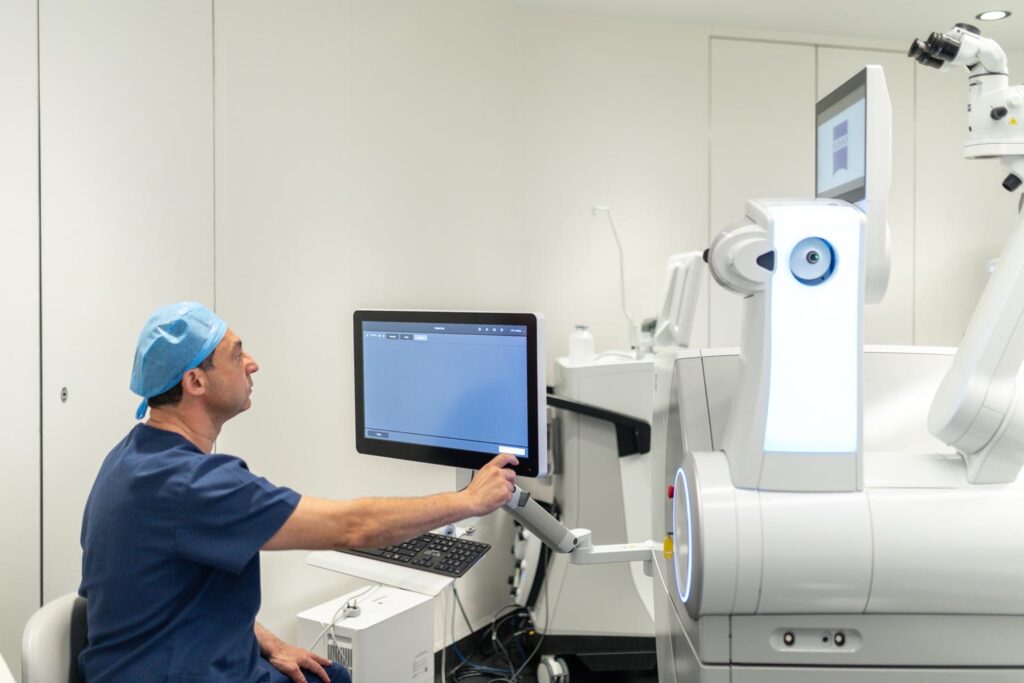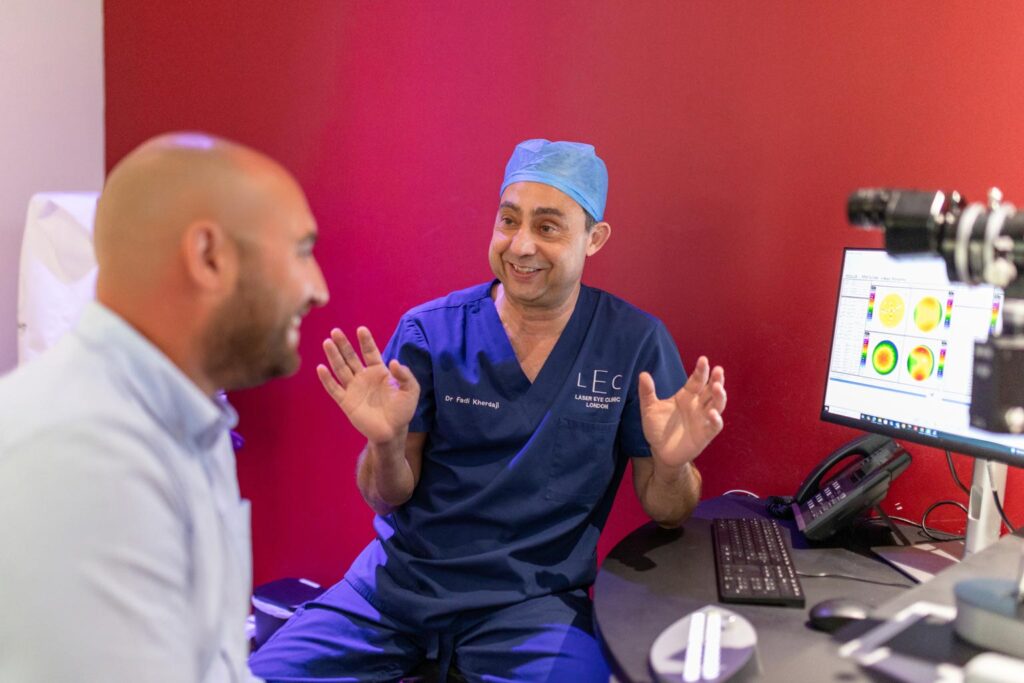What to Expect Before, During and After Treatment.
Fear of pain is one of the most common reasons people hesitate to book laser eye surgery. I hear it almost daily in clinic: “Does it hurt?” “Will I feel the laser?” “What if I blink or move?” These are natural questions, especially when the eyes are involved.
The good news is that modern laser eye surgery is designed to be comfortable. With anaesthetic eye drops, precise computer-guided technology and a short treatment time, most patients describe the experience as completely painless. You may feel mild pressure or a strange awareness of light, but pain is not part of the process.
Let’s walk through exactly what you can expect; before, during and after your surgery and why fear of discomfort should never stand between you and clear vision.
Why people imagine it hurts
Decades ago, early laser treatments involved longer exposure times and less sophisticated anaesthetic methods. Understandably, stories from those early years still circulate. Today’s procedures are very different.
Modern lasers operate in seconds, guided by real-time eye-tracking systems that adjust for even the slightest movement. The cornea contains no pain receptors, which means the reshaping itself cannot be felt once the surface is numb. Any temporary sensations that do occur are from the eyelids or the natural pressure of the surgical ring, not the laser beam.

Before surgery, complete comfort from the start
When you arrive on treatment day, anaesthetic eye drops are applied to numb the surface of the eye completely. There are no needles or injections. Within thirty seconds, the drops take full effect.
The eyelids are then gently held open with a small device to prevent blinking. Most patients expect this to feel strange, but it causes no discomfort, it simply holds the lashes out of the way. You can still move your eyes naturally and focus on a small light. Throughout the procedure, you remain awake, breathing normally, and able to communicate with the surgical team.
Some clinics offer an optional mild sedative tablet beforehand for patients who feel anxious. I often remind people that the procedure itself takes less time than brushing your teeth. Once you are in the chair, you will be finished within minutes.
During surgery, what you will actually feel
Each laser technique feels slightly different, so let’s explore them individually.
SMILE Pro
SMILE Pro is the gentlest laser vision correction available today. It is completely flap-free and performed through a micro-keyhole about two millimetres wide. You may feel a light pressure for a few seconds as the laser creates a small internal lenticule of tissue, which is then removed. There is no burning smell, no heat, and no pain. The most common comment afterwards is surprise at how quick and uneventful it felt.
LASIK
In LASIK, a thin surface layer called a flap is created and lifted before the laser reshapes the underlying tissue. You might notice a feeling of slight pressure while the flap is created; similar to someone gently pressing a contact lens against your eye. The laser itself is silent and painless. When the flap is repositioned, vision clears almost instantly.
PRK or LASEK
PRK or LASEK surface treatments are used when the cornea is too thin for LASIK. The top layer of cells is gently loosened and the laser reshapes the cornea directly. Because the surface needs time to regrow, you may experience mild soreness for one or two days afterwards. Pain relief drops are provided to keep you comfortable while healing occurs.
Across all techniques, there is no moment of sharp pain. Most people describe only curiosity: lights, clicking sounds, a brief dimming of vision, and then clarity.
Immediately after, what happens in the first few hours
Once the procedure is complete, we apply lubricating drops and rest the eyes for a few minutes. The anaesthetic effect wears off gradually. You may then notice mild grittiness or watering, as if an eyelash were in the eye. This sensation fades within a few hours.
Many patients nap when they return home. By the evening, most LASIK and SMILE patients already see clearly and feel minimal discomfort. Light sensitivity or mild dryness is common for the first day or two, which is easily managed with protective sunglasses and prescribed lubricating drops.
With PRK or LASEK, recovery takes a little longer because the surface cells must regenerate. Temporary soreness can last two to three days, controlled with medicated drops and protective contact lenses.
The first week, adapting to new clarity
In the days that follow, the most common sensations are dryness, slight fluctuations in vision, and sensitivity to bright light. These are part of the normal healing process. The corneal nerves that regulate tears are temporarily relaxed and gradually restore function over several weeks.
I encourage patients to use preservative-free lubricants frequently, avoid rubbing their eyes, and limit heavy exercise for a few days. Most people return to work within forty-eight hours after LASIK or SMILE, and within five to seven days after PRK.
The key point is that none of this involves true pain, only mild irritation or awareness that the eyes are recovering from precision treatment.
Comparing comfort between procedures
To summarise:
| Procedure | During Treatment | After Treatment | Recovery Comfort |
| SMILE Pro | No pain, light pressure | Mild dryness for 1-2 days | Easiest overall |
| LASIK | No pain, gentle pressure during flap | Grittiness for 1 day | Rapid clarity |
| PRK/LASEK | No pain during laser | Soreness for 2-3 days | Longer healing but safe |
SMILE Pro generally offers the smoothest experience. Because it leaves the surface intact, there is less dryness and quicker visual stability. LASIK follows closely behind with excellent comfort and near-instant recovery. PRK and LASEK are slightly more demanding post-operatively, but still very manageable with modern pain relief and medication.

What if I blink or move during surgery?
Many people worry they might ruin the procedure by blinking or looking away. Modern laser systems make that impossible.
An eyelid holder prevents blinking, and a sophisticated eye-tracking camera follows every microscopic movement in real time. The laser only activates when your eye is in perfect alignment. If you sneeze or cough, the system pauses automatically.
Knowing this in advance helps most patients relax the moment the procedure begins.
When discomfort means something more
True pain after laser eye surgery is rare. However, persistent or increasing discomfort should always be checked. Contact your surgeon if you experience:
- Severe redness or swelling
- Sharp pain that does not settle with lubricants
- Sudden drop in vision
- Discharge or excessive tearing
These symptoms may indicate dryness, inflammation or, very rarely, infection; all treatable when addressed early. My team provides direct after-hours contact so patients can reach us immediately if anything feels unusual.
Emotional comfort, the part people forget
Pain is not only physical. Anxiety before any procedure can heighten perception and make normal sensations feel amplified. That is why I take time to explain every step in detail during consultation and on the day of surgery. Knowing exactly what will happen removes uncertainty and helps the body stay relaxed.
Most patients describe a sense of calm once they realise how quick and gentle the process is. Within minutes, they walk out seeing more clearly than they imagined possible.
What our patients say
I often hear the same sentence repeated at follow-up appointments: “I can’t believe I was so worried about the pain.” One recent patient described the experience as “less uncomfortable than a dental cleaning.” Another said, “I kept waiting for it to hurt, but it never did.”
These genuine reactions reflect what I see every day that fear of pain is almost always worse than the procedure itself.

Why modern eye surgery is truly comfortable
The evolution of laser technology has focused as much on comfort as on accuracy. Today’s femtosecond and excimer lasers operate so precisely that they remove tissue cell by cell without generating heat or vibration. Combined with advanced surface cooling and lubrication, they allow patients to walk out minutes later without bandages or visible signs of surgery.
SMILE Pro, in particular, has transformed expectations. Its micro-incision technique leaves the eye structurally strong, reduces dryness, and produces minimal post-operative sensitivity. This is why I recommend it to patients who are nervous about discomfort or who have active lifestyles.
Gentle Laser Technology
Laser eye surgery should not be painful. With modern anaesthesia, gentle laser technology and careful aftercare, discomfort is limited to mild dryness or awareness for a short period. Understanding what to expect is the best way to replace fear with confidence.
If your eyes are healthy and your prescription is stable, you can look forward to a fast, comfortable experience that provides years of freedom from glasses or contact lenses. The key is choosing a clinic that values patient education, precision diagnostics and personal attention throughout the journey.
Closing thoughts from Dr Fadi Kherdaji
“I understand the worry that surrounds eye surgery. The idea of a laser touching the eye sounds intimidating until you experience how refined the process truly is. My role is to remove that fear through clear explanation, careful technique and genuine care for each patient’s comfort.
In over twenty years of performing refractive surgery, I have seen technology evolve to the point where pain is simply not part of the experience. What remains is a few minutes of calm precision that changes how people see the world. My advice to anyone considering it is simple, don’t let fear of discomfort hold you back. The gift of clear vision far outweighs a few minutes of gentle awareness.”



